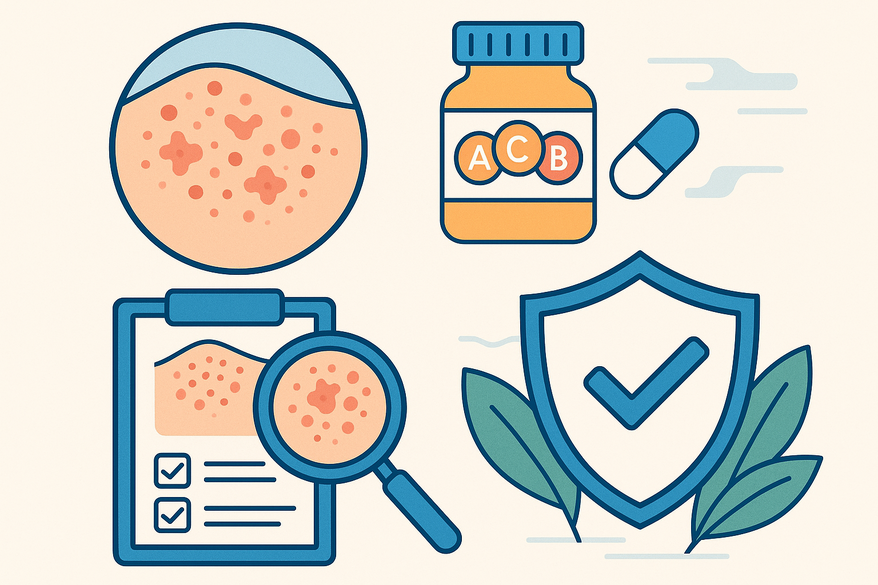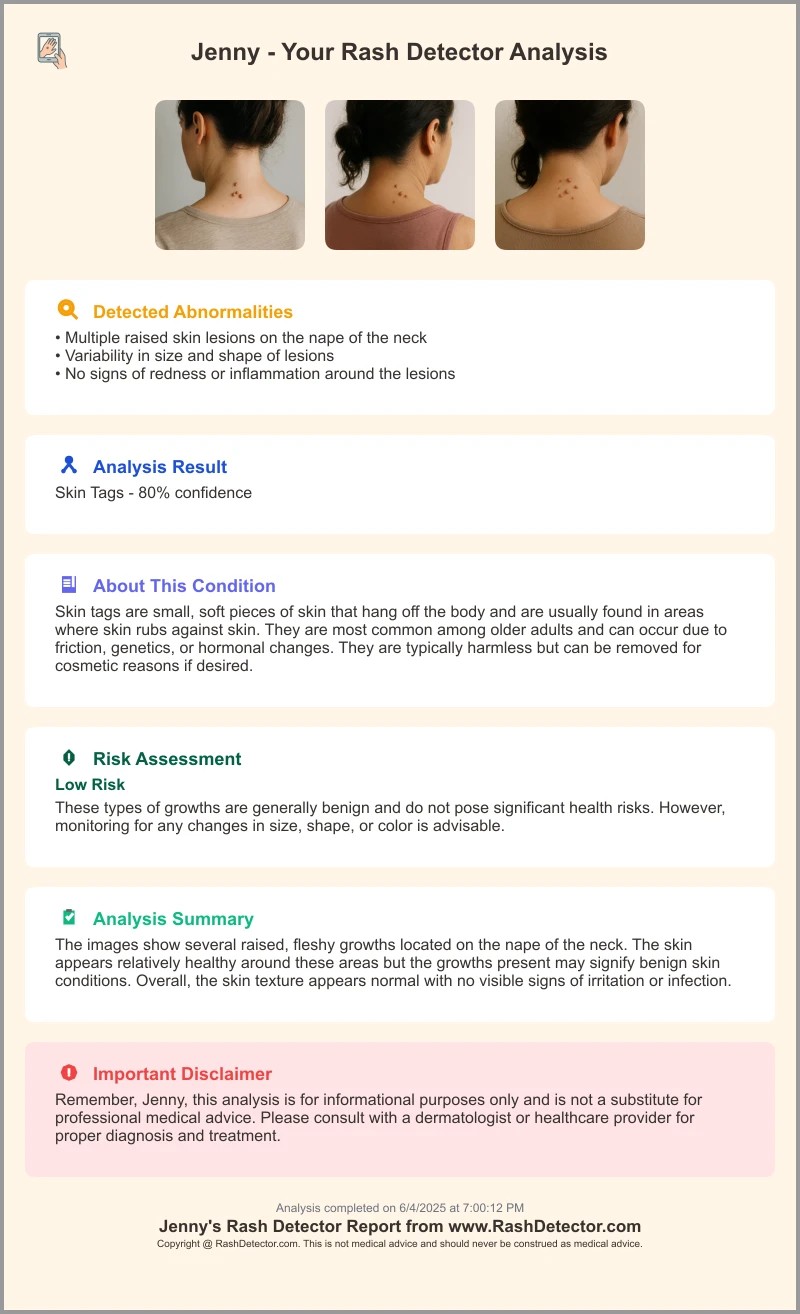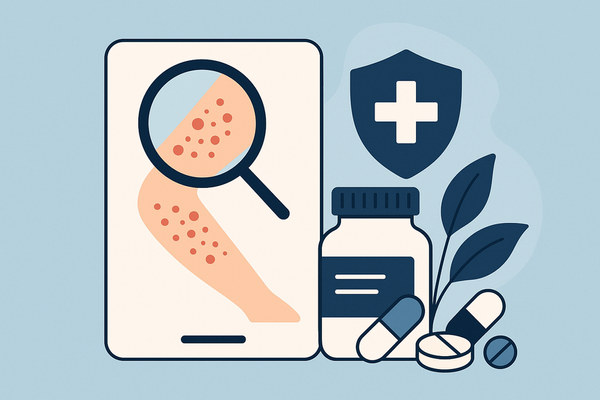Vitamin Deficiency Rash Symptoms: Causes, Detection & Treatment
Learn how to identify and treat vitamin deficiency rash symptoms. Discover essential vitamins for skin health, diagnostic steps, and prevention strategies.

Estimated reading time: 8 minutes
Key Takeaways
- Essential skin nutrients: Vitamins A, B complex, C, D, E, and K maintain barrier function, collagen synthesis, and repair.
- Deficiency patterns: B6, B3 and C deficiencies cause distinct rash presentations like greasy scaly patches, pellagra dermatitis, and keratosis pilaris.
- Early recognition: Visual clues plus tools like Rash Detector enable prompt detection and intervention.
- Management: Balanced diet, targeted supplementation, and topical care restore skin integrity and prevent complications.
- When to consult: Persistent rashes with systemic signs—fatigue, anemia, mouth sores—warrant medical evaluation.
Table of Contents
- Introduction
- Understanding Vitamin Deficiencies and Skin Health (Section 1)
- Link Between Specific Vitamin Deficiencies and Rash Symptoms (Section 2)
- Recognizing the Symptoms of Vitamin Deficiency Rashes (Section 3)
- Diagnosis and Medical Consultation (Section 4)
- Prevention and Management (Section 5)
- Conclusion
- FAQ
Introduction
Vitamin deficiency rash symptoms are visible skin changes—rashes—that result from inadequate intake or absorption of key vitamins. Early recognition of these skin signs is vital to prevent systemic health issues such as anemia, immune dysfunction, and cognitive impairment. When you spot a rash early, you can correct underlying deficiencies before they worsen (Merck Manuals).
- An overview of vitamins essential for skin health
- How specific deficiencies cause distinct rashes
- Tips for self-recognition of nutrient-related eruptions
- Diagnostic steps and when to seek medical consultation
- Prevention strategies and management approaches for lasting skin health
Integrating digital tools can streamline early recognition: with Rash Detector, you can upload images of suspicious rashes and receive instant AI-powered analysis, complementing clinical evaluation.

Section 1: Understanding Vitamin Deficiencies and Skin Health
Defining Vitamin Deficiencies
Vitamin deficiencies occur when body levels of essential micronutrients fall below the amount needed for normal function. Poor diet, malabsorption disorders, or increased physiological demands can lead to shortages.
Vitamins Essential for Skin
- Vitamin A – supports cell regeneration and repair
- B Complex – critical for metabolism, barrier function, and collagen synthesis
- B2 (riboflavin): energy metabolism; skin repair
- B3 (niacin): DNA repair; barrier integrity
- B6 (pyridoxine): collagen synthesis; immune defense
- B7 (biotin): keratin health; hair and nail strength
- B9 (folate): cell division; tissue growth
- B12 (cobalamin): red blood cell formation; nerve function
- Vitamin C – collagen cross-linking; potent antioxidant
- Vitamin D – immune regulation; barrier integrity
- Vitamin E – protects against oxidative damage
- Vitamin K – supports wound healing and clotting
How Deficiencies Disrupt Skin Function
When vitamins are low, cell turnover slows, collagen production falters, and the skin barrier weakens. This leads to:
- Poor wound healing
- Dry, flaky or scaly skin
- Increased susceptibility to infections and dermatitis
Section 2: Link Between Specific Vitamin Deficiencies and Rash Symptoms
Subsection A – Vitamin B6 Deficiency Rash
Role: Pyridoxine (B6) is vital for collagen formation, keratinocyte turnover, and immune defense. When B6 is insufficient, barrier integrity suffers and skin repair stalls.
Clinical Presentation: Red, greasy, scaly patches in seborrheic distribution; cheilosis; itching and burning.
Mechanism: Impaired amino acid conversion weakens epidermal support and increases sebum production.
Subsection B – Pellagra Rash: Vitamin B3 Deficiency
Role: Niacin supports NAD/NADP coenzymes for DNA repair and barrier maintenance.
Clinical Presentation: Photosensitive dermatitis on sun-exposed areas, hyperpigmentation, scaling; systemic: dermatitis, diarrhea, dementia.
Mechanism: UV-induced DNA damage accumulates without niacin, causing inflammation and pigment changes.
Subsection C – Keratosis Pilaris: Vitamin C Deficiency Rash
Role: Ascorbic acid ensures hydroxylation of collagen and neutralizes free radicals.
Clinical Presentation: Rough, acne-like bumps on arms and thighs; fragile skin prone to bruising.
Mechanism: Defective collagen synthesis leads to follicular plugging and capillary fragility.
Subsection D – Other Vitamin Deficiency Rash Symptoms
- Vitamin D: may exacerbate psoriasis and atopic dermatitis
- Vitamin A: dryness, scaling, follicular hyperkeratosis
- Vitamin E: oxidative protection, less overt rash
- Vitamin K: bruising, slow healing
- B2, B9, B12: nonspecific dermatitis, angular cheilitis, glossitis
Section 3: Recognizing the Symptoms of Vitamin Deficiency Rashes
Common Presentations: B6: red, greasy patches on scalp/face/neck/chest; B3: photosensitive hyperpigmented rash; C: keratosis pilaris bumps; A & E: dryness and fine scaling; B2/B9/B12: cheilitis, sore tongue.
Systemic Signs: fatigue, anemia, mouth ulcers, hair thinning.
Self-Assessment Tips: Check symmetry, photodistribution, and concurrent systemic symptoms to suspect micronutrient gaps.
Section 4: Diagnosis and Medical Consultation for Vitamin Deficiency Rash Symptoms
- Clinical exam: rash distribution, mucous membranes
- Dietary assessment: 24-hour recall, food frequency
- Lab tests: serum vitamin levels, CBC
- Correlate results: monitor rash improvement with supplementation
- Seek help if rash persists, systemic signs appear, or malabsorption is suspected
Section 5: Prevention and Management of Vitamin Deficiency Rash Symptoms
Dietary Recommendations
- Vitamin B6: poultry, fish, potatoes, bananas
- Vitamin B3: meat, fish, legumes, fortified cereals
- Vitamin C: citrus fruits, bell peppers, broccoli
- Vitamin D: fatty fish, fortified dairy, safe sun exposure
- Vitamin A: liver, carrots, sweet potatoes
- Vitamin E: nuts, seeds, spinach
- Vitamin K: leafy greens, broccoli, Brussels sprouts
Emphasize a balanced diet rich in colorful fruits, vegetables, lean proteins, whole grains, and healthy fats.
For an expert-backed post-rash care routine to soothe irritation and promote healing, see https://blog.rashdetector.com/ultimate-post-rash-care.
Supplementation Guidance
- Use under healthcare supervision—avoid high-dose self-prescription
- Monitor for hypervitaminosis (e.g., B6 neuropathy)
Rash Symptom Management
- Gentle, fragrance-free cleansers and moisturizers
- Topical soothing agents (low-potency corticosteroids as needed)
- B6-containing creams for seborrheic-type rashes pending systemic correction
Detailed strategies for after-rash detection skin care are available at https://blog.rashdetector.com/after-rash-detection-skin-care-guide.
Conclusion
Vitamin deficiency rash symptoms serve as early warning signs of underlying nutritional gaps—most notably deficiencies in vitamins B6, B3, and C. A balanced, vitamin-rich diet paired with timely medical evaluation can restore skin barrier integrity, resolve eruptions, and prevent systemic complications. If you notice unusual or persistent rashes alongside fatigue, mouth sores, or digestive issues, consult a healthcare provider for targeted testing and personalized treatment. Early intervention ensures both healthy skin and overall well-being.
For more on identifying and treating general red itchy rashes, see https://blog.rashdetector.com/red-itchy-rash-treat.
FAQ
- Which vitamin deficiency causes scaly, red patches?
Insufficient vitamin B6 often leads to red, greasy, scaly patches around the scalp, face, and chest. - How can I test for vitamin deficiencies?
A healthcare provider can order blood tests to measure serum levels of key vitamins and a complete blood count (CBC) to assess related systemic effects. - Are vitamin deficiency rashes reversible?
Yes, most rashes improve with dietary changes or supplementation, but proper diagnosis and guidance ensure safe correction. - When should I see a doctor?
If a rash persists despite improved nutrition or is accompanied by systemic symptoms like fatigue, anemia, or digestive issues, seek medical evaluation.





